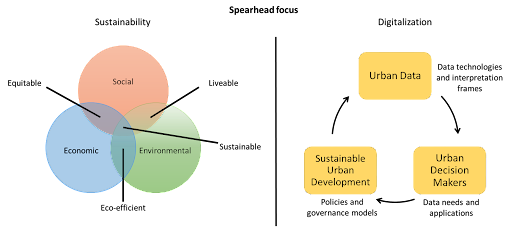Improving Sustainable Behavior in Cities through Digitalization
In accordance with the United Nations Sustainable Development Goal 11, sustainable cities and communities, many governments have put sustainability in cities and higher environmental consciousness among the population on top of their agendas.
Complex problems require holistic approaches and solutions
Sustainability in cities is a complex construct, because it concerns citizens, companies, public services and policy makers alike. Further, it deals with a variety of topics such as land use and physical infrastructure, technology and digital infrastructure, transportation and mobility, pollution, energy and resource efficiency, education, safety and stability, health and well-being, economic viability, product life-cycle, material flows and many more. Often, these topics are clustered into three key factors of urban living: Social, environmental and economic aspects.
The sustainable city is attractive to live and work in, because it combines best practices of all key areas into one holistic concept that serves all stakeholders equally. Further, it is highly connected, both digitally and physically. Urban regions around the world struggle to create liveable, eco-efficient and equitable cities with access to and connections between important destinations and services. At the same time, innovation and technological advancement cause continuous changes in urban lifestyles and behavior of citizens. One recent challenge is the competition between offline and online products and services offerings for residents as well as visitors. The question of how to address this and other challenges in a sustainable way cannot be answered in a generic way. To develop appropriate policies and governance models that serve all stakeholders, urban decision-makers need detailed information on the specific nature of the problems in their city.

Diverse perspectives on the urban sustainability challenge
Building a viable city is easier said than done, because the many different stakeholders have many different interests. From a marketing perspective, developments such as online shopping, delivery services for food and other products as well as digital entertainment alternatives compete against offline businesses settled in city centres.
Counteracting these circumstances or rethinking their own business is crucial for shop owners to survive. At the same time, it is in the interest of municipalities to preserve viable city centers. Therefore, researchers study consumer behavior in cities to prevent city centers from dying because of online shopping competition and similar changes brought about by digitalization, while keeping in mind government policies and sustainability criteria of urban living. The results of such studies help business owners to stay competitive by adjusting their business model to the changes brought about by digital product and service offerings. Depending on the business, this can include increasing positive customer experience onsite through personalized marketing communication, special deals only available in offline shopping, etc. New developments are also combination deals in cooperation with a complimentary business where a clothing store hands out discounts for the café next door or the parking garage has discounted fees for clients of certain businesses.
From a behavioral perspective, the sustainability challenge is e.g. to achieve a long-term change in people’s mobility habits to the benefit of non-motorized and public transport. To trigger change in behavior, we need to understand current behavior including the drivers for mobility-related decisions. Such mobility-related factors of interest are mode of transportation, trip routing, trip timing, destination location, etc. for various trip purposes and while considering demographics of the individual. Using this information, researchers can group citizens into different categories based on their mobility profiles and transport mode use. In a next step, public services and mobility service providers develop targeted offerings for citizens that fit their needs best while reducing their carbon footprint and making urban living more sustainable.
From a governmental perspective, the sustainability challenge is to set the right agenda with feasible targets and to push for more sustainable action and decisions among all stakeholders of a city equally. Necessary actions differ per stakeholder and deal with various topics, which can potentially lead to conflicts of interest. Therefore, it is important to take this holistic view and to consider all stakeholders of the city, consider how each of them can contribute to more sustainable urban living and to simulate how certain changes enforced by policies and restrictions will affect the stakeholders.
How digitalization can help
Researchers in this field use urban data to understand and assess the behaviour of individuals in cities as well as key sustainability issues of today’s cities and develop and implement policies to address these issues. Recent studies make use of digitalization and ubiquitous computing devices for data generation.
On the one hand, relevant novel data include personal information such as mobile phone data e.g. GPS tracking data, online browsing behaviour, social media data, purchasing information via e.g. MasterCard, public transport use via e.g. OV Chipkaart data, health data from e.g. FitBit, etc.
On the other hand, research uses remote-sensing data about the environment to create results that are also spatially explicit. Such data include information about the built environment and green spaces of a city, carbon intensity and air pollution, noise pollution, traffic information, etc.
Combining multiple such datasets is complicated due to data privacy regulations, but whenever possible, the combined dataset leads to insights based on actual behavior. Focusing on data collection through ubiquitous computing devices and integrating multiple big data sources will allow research to grasp citizens’ behaviour better and to use digitalization to achieve more sustainability in urban areas.
Also read
-
Globalisation & Law Network seminar with Rodrigo Vallejo Garretón
On 4 July 2025, the Globalisation & Law Network had the pleasure of welcoming Dr Rodrigo Vallejo Garretón, Assistant Professor in Private Law at the University of Amsterdam.

-
Language policy in European higher education
The increased Englishization of higher education is under discussion in several European countries. What does a balanced language policy look like that does justice to both the increasingly international character of higher education and a country's language-related cultural identity? At an...

-
A pinch of LSD, taken twice daily with meals
Fast forward to 2040: if you have ADHD or another psychological disorder, the doctor may no longer prescribe Ritalin or antidepressants, but instead a low dose of magic mushrooms, truffles or LSD. Associate professor Kim Kuypers is studying the use of psychedelics as potential medicines of the...
